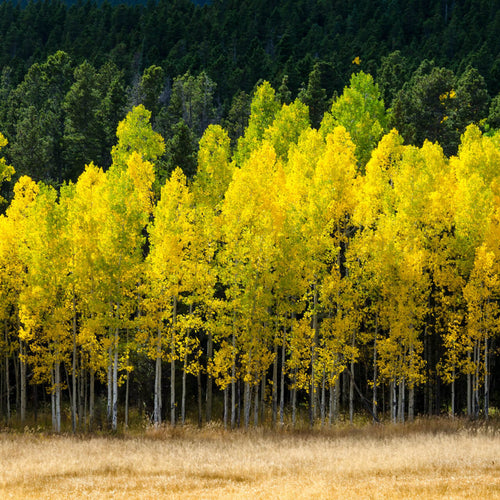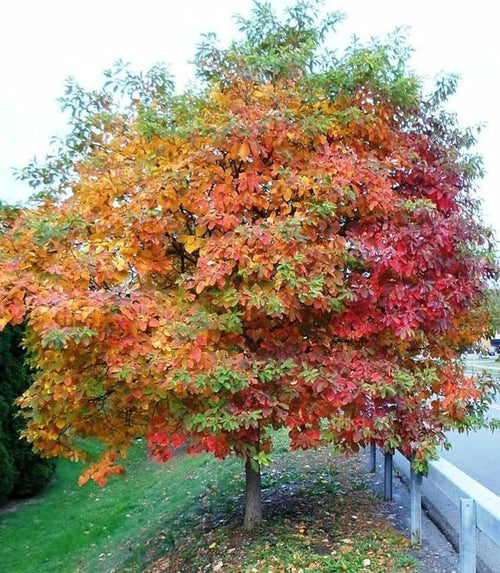Exploring Nature's Palette through Sassafras, Red Oak, Sugar Maple, and Quaking Aspen Trees
As the sweltering heat of summer gradually gives way to the crisp and refreshing embrace of autumn, nature orchestrates one of its most dazzling displays – the transformation of leaves into a vibrant tapestry of colors. Trees play a starring role in this visual spectacle, with each species contributing unique hues to the grand canvas of fall foliage. Among the trees that offer stunning autumn displays, the Sassafras, Red Oak, Sugar Maple, and Quaking Aspen stand out as true champions of chromatic beauty.
Sassafras Trees (Sassafras albidum):
With its distinctive mitten-shaped leaves and warm and bright colors, the Sassafras tree is a true emblem of autumn's artistic prowess. Native to eastern North America, the Sassafras tree showcases a palette ranging from rich yellows and oranges to deep reds and purples. One of the most captivating aspects of Sassafras foliage is its variety within a single tree. It's not uncommon to witness different leaf shapes and colors on the same Sassafras tree, which adds an intriguing element to its fall display. The Sassafras tree's vibrant fall foliage comes from the chemical compounds within the leaves. Carotenoids produce the yellow and orange hues, while anthocyanins are responsible for the red and purple shades. These compounds become more pronounced as the season changes, creating a breathtaking visual feast for onlookers. The Sassafras's vibrant fall foliage can be appreciated in forests, parks, and suburban and urban settings, making it a cherished contributor to autumn landscapes.
Red Oak Trees (Quercus rubra):
Another illustrious participant in the fall foliage extravaganza is the Red Oak tree, a grand denizen of North American forests. Renowned for its stately presence and sturdy wood, the Red Oak's leaves transform into a radiant symphony of colors as autumn arrives. The leaves transition from deep green to a captivating red, russet, and brown medley. Their distinctive jagged edges add a touch of character to the overall display. The Red Oak's autumnal transformation is influenced by sunlight, temperature, and moisture. As the days shorten and temperatures drop, chlorophyll production – the pigment responsible for the green color in leaves – slows down and eventually ceases. This allows other pigments, such as carotenoids and anthocyanins, to emerge and dominate the leaves' appearance. The result is a breathtaking panorama of warm and earthy tones that define the essence of fall.
Sugar Maple Trees (Acer saccharum):
When it comes to iconic fall foliage, the Sugar Maple tree reigns supreme. The Sugar Maple is revered for producing the quintessential autumn landscape. This native North American tree transforms the landscape into a breathtaking mosaic of vibrant colors. From brilliant yellows to deep oranges and fiery reds, the Sugar Maple's leaves capture the essence of fall in all its glory. The Sugar Maple owes its remarkable fall display to its high concentration of pigments and their intricate interactions. As daylight decreases and temperatures turn cooler, chlorophyll production wanes, revealing the underlying pigments. The Sugar Maple's leaves contain a combination of carotenoids, which yield yellow and orange hues, and anthocyanins, responsible for the fiery reds. The Sugar Maple's ability to consistently produce a stunning array of colors has earned it the "autumn blaze."
Quaking Aspen Trees (Populus tremuloides):
In regions where vast groves of Quaking Aspen trees thrive, autumn brings a remarkable spectacle of shimmering gold. These trees, native to North America, are distinct not only for their distinctive, flattened leaf stems that cause the leaves to flutter in the slightest breeze but also for the remarkable color transformation they undergo in fall. The Quaking Aspen's leaves turn into a luminous display of yellow and gold, giving the impression of sunlight filtering through the canopy. This transformation is brought about by the breakdown of chlorophyll, which unmasks the carotenoid pigments already present in the leaves. The result is a breathtaking expanse of golden leaves that dance with the wind.
The autumnal transformation of trees into a vibrant array of colors is a true masterpiece of nature. Among the numerous contributors to this spectacle, the Sassafras, Red Oak, Sugar Maple, and Quaking Aspen trees stand out as champions of chromatic diversity. Their unique leaf shapes and stunning color palettes add richness and depth to the landscapes during the fall season. From the Sassafras tree's multicolored foliage to the Sugar Maple's fiery reds, each species offers a glimpse into the kaleidoscope of nature's artistry. So, as autumn approaches, please take a moment to immerse yourself in the beauty of these trees and witness the magic that unfolds as nature paints the world with its vibrant fall foliage.




















































